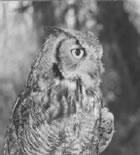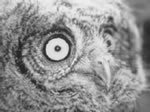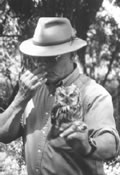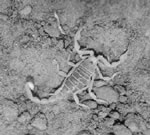|
 I’m not sure what the drivers
think. Their headlights illuminate a lone figure standing
beneath an old gnarled tree growing in the middle of Moab.
The figure’s head is tilted upwards, as if he is looking
for something in the crystalline heaven above. But he isn’t
looking that far away.
I’m not sure what the drivers
think. Their headlights illuminate a lone figure standing
beneath an old gnarled tree growing in the middle of Moab.
The figure’s head is tilted upwards, as if he is looking
for something in the crystalline heaven above. But he isn’t
looking that far away.
 The
next set of headlights catches the figures with lips pursed,
and if the car windows are rolled down, the driver might catch
an accelerating series of toots emanating from the lone figure.
Weird? Perhaps. But then again, I wish they would turn off
their headlights - it ruins my night vision. The reason for
my behavior is simple - I’m trying to call in an owl
that lives within an old woodpecker hole high up in this gnarled
tree. The
next set of headlights catches the figures with lips pursed,
and if the car windows are rolled down, the driver might catch
an accelerating series of toots emanating from the lone figure.
Weird? Perhaps. But then again, I wish they would turn off
their headlights - it ruins my night vision. The reason for
my behavior is simple - I’m trying to call in an owl
that lives within an old woodpecker hole high up in this gnarled
tree.
The owl I’m after is a seven-ounce terror to small rodents,
songbirds and insects. Better known as the western screech
owl, this nocturnal dweller has eluded my observation for
several weeks. But tonight, the gig is up.
Western screech
owls don’t screech very often. In fact, it is very rare
to hear this type of vocalization. Normally, I only catch
their series of hollow whistles punctuated by a quick trill
piercing the darkness. Like most owls, the screech owls call
is of the low-frequency variety for better long distance,
night-time communication.
 Other
features that enable these birds to conduct their business
in the dark are their proportionally large heads that house
eyes designed for low-light levels; acute hearing due to parabolic-shaped
facial discs that channel sound into ear openings; and long,
soft feathers designed for stealth flight. During the day,
their cryptic coloration helps them blend into their surroundings
to avoid detection by larger, diurnal raptors. Other
features that enable these birds to conduct their business
in the dark are their proportionally large heads that house
eyes designed for low-light levels; acute hearing due to parabolic-shaped
facial discs that channel sound into ear openings; and long,
soft feathers designed for stealth flight. During the day,
their cryptic coloration helps them blend into their surroundings
to avoid detection by larger, diurnal raptors.
Though there are
about four species of owls that nest within a couple miles
of my Moab City home, the screech owl seems best adapted to
life in the urban community. Though preferring a tree hollow
or an old woodpecker cavity for their nest site, screech owls
readily take to nest boxes if no natural nesting site exists.
 In
their protective cavities, the female owl usually lays 4-5
white, oval eggs. She is also the primary incubator, although
the male will provide food for his mate while she incubates
the eggs. After about 26 days, the eggs hatch, and in another
month, the young will be able to fly. In
their protective cavities, the female owl usually lays 4-5
white, oval eggs. She is also the primary incubator, although
the male will provide food for his mate while she incubates
the eggs. After about 26 days, the eggs hatch, and in another
month, the young will be able to fly.
For their first
few weeks of life outside of the nest, the young will learn
to hunt from their parents. Insects, mice, grasshoppers, moths,
songbirds, lizards, toads, scorpions, all may find themselves
on the nighttime menu. Sometimes one can find the young gathered
together, balancing on a tree limb or roof peak, awaiting
parental instructions. Occasionally a home owner finds a terrorized
cat spinning wildly in the yard trying to shake the bare-back
rider who has mistaken the cat for a potential source of food.
 So
some night this April, go stand outside your house. Listen
for the soft whistled notes of the screech owl or, if you
live near the surrounding cliffs, the deep whooos of a great
horned owl. Imagine the screech owl, head bobbing (because
their eyes are fixed within their sockets and cannot move
independently) listening for the faint sounds of mice moving
across the fields or the wing beats of a moth. Captured prey
equates to food for its mate sitting on eggs in some tree
cavity. On the return flight the owl must dodge cars and power
lines and prowling cats, hazards of urban living. And if you
are like me, you’ll wish that people would dim their
headlights as they round the corner and illuminate you standing
in your yard with your head tilted upwards listening for those
accelerating toots. So
some night this April, go stand outside your house. Listen
for the soft whistled notes of the screech owl or, if you
live near the surrounding cliffs, the deep whooos of a great
horned owl. Imagine the screech owl, head bobbing (because
their eyes are fixed within their sockets and cannot move
independently) listening for the faint sounds of mice moving
across the fields or the wing beats of a moth. Captured prey
equates to food for its mate sitting on eggs in some tree
cavity. On the return flight the owl must dodge cars and power
lines and prowling cats, hazards of urban living. And if you
are like me, you’ll wish that people would dim their
headlights as they round the corner and illuminate you standing
in your yard with your head tilted upwards listening for those
accelerating toots.
|

 The
next set of headlights catches the figures with lips pursed,
and if the car windows are rolled down, the driver might catch
an accelerating series of toots emanating from the lone figure.
Weird? Perhaps. But then again, I wish they would turn off
their headlights - it ruins my night vision. The reason for
my behavior is simple - I’m trying to call in an owl
that lives within an old woodpecker hole high up in this gnarled
tree.
The
next set of headlights catches the figures with lips pursed,
and if the car windows are rolled down, the driver might catch
an accelerating series of toots emanating from the lone figure.
Weird? Perhaps. But then again, I wish they would turn off
their headlights - it ruins my night vision. The reason for
my behavior is simple - I’m trying to call in an owl
that lives within an old woodpecker hole high up in this gnarled
tree. Other
features that enable these birds to conduct their business
in the dark are their proportionally large heads that house
eyes designed for low-light levels; acute hearing due to parabolic-shaped
facial discs that channel sound into ear openings; and long,
soft feathers designed for stealth flight. During the day,
their cryptic coloration helps them blend into their surroundings
to avoid detection by larger, diurnal raptors.
Other
features that enable these birds to conduct their business
in the dark are their proportionally large heads that house
eyes designed for low-light levels; acute hearing due to parabolic-shaped
facial discs that channel sound into ear openings; and long,
soft feathers designed for stealth flight. During the day,
their cryptic coloration helps them blend into their surroundings
to avoid detection by larger, diurnal raptors.  In
their protective cavities, the female owl usually lays 4-5
white, oval eggs. She is also the primary incubator, although
the male will provide food for his mate while she incubates
the eggs. After about 26 days, the eggs hatch, and in another
month, the young will be able to fly.
In
their protective cavities, the female owl usually lays 4-5
white, oval eggs. She is also the primary incubator, although
the male will provide food for his mate while she incubates
the eggs. After about 26 days, the eggs hatch, and in another
month, the young will be able to fly.  So
some night this April, go stand outside your house. Listen
for the soft whistled notes of the screech owl or, if you
live near the surrounding cliffs, the deep whooos of a great
horned owl. Imagine the screech owl, head bobbing (because
their eyes are fixed within their sockets and cannot move
independently) listening for the faint sounds of mice moving
across the fields or the wing beats of a moth. Captured prey
equates to food for its mate sitting on eggs in some tree
cavity. On the return flight the owl must dodge cars and power
lines and prowling cats, hazards of urban living. And if you
are like me, you’ll wish that people would dim their
headlights as they round the corner and illuminate you standing
in your yard with your head tilted upwards listening for those
So
some night this April, go stand outside your house. Listen
for the soft whistled notes of the screech owl or, if you
live near the surrounding cliffs, the deep whooos of a great
horned owl. Imagine the screech owl, head bobbing (because
their eyes are fixed within their sockets and cannot move
independently) listening for the faint sounds of mice moving
across the fields or the wing beats of a moth. Captured prey
equates to food for its mate sitting on eggs in some tree
cavity. On the return flight the owl must dodge cars and power
lines and prowling cats, hazards of urban living. And if you
are like me, you’ll wish that people would dim their
headlights as they round the corner and illuminate you standing
in your yard with your head tilted upwards listening for those